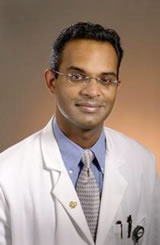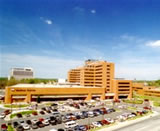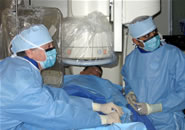 |

|
 |

Dr. Sunil V.
Rao is Assistant Professor of Medicine at Duke University
Medical Center and serves
as Director of the Cardiac Cath Lab at the Durham VA Medical
Center, Durham,
North Carolina.
Dr. Rao's focus of research is in bleeding and transfusion
issues in patients with ischemic heart disease, quality assessment
and improvement through registries, as well as early
phase clinical trials in interventional cardiology. He is
a regular speaker at major international cardiology meetings
and has authored many articles on the subject of bleeding
complications.
His
landmark study, "Trends
in the Prevalence and Outcomes of Radial and Femoral Approaches
to Percutaneous Coronary Intervention",
which appeared in the September issue of the Journal
of the American College of Cardiology: Cardiac Interventions,
is widely credited with increasing awareness of the safety
benefits associated with the transradial approach to PCI.
For more about the transradial approach, visit
our Radial
Access Center. |
|

Sunil V.
Rao, MD, FACC |
Q: Do you have any updated information from your
major study about the transradial approach that was published
last fall in JACC Interventions? Are you working on other studies
of this
type?
Dr. Rao: We have quite a few studies in the planning stages to look
at various aspects of the benefits as well as the risks associated
with transradial. For example, if we accept the argument that bleeding
complications are associated with increased mortality and we accept
the argument that transradial is associated with less bleeding complications,
is there an association then between transradial and improved survival
in patients undergoing PCI? That's a question a lot of people will
ask and we're in the process of planning analyses looking at both
short and long term survival. Then the other big thing, of course,
is that one of the major drivers of healthcare cost in the PCI population
is bleeding complications which lead to increased length of stay.
And so is there an association between radial approach and reduced
healthcare costs? There have been some smaller studies that have
looked at that but I think we've got the capability to look at that
on a very very large scale. So those things are in the planning stages.
Q: Didn’t the M.O.R.T.A.L.
study that was done with the Canadian registry population try
to make
the linkage between lower
complications and lower mortality?
Dr. Rao: Yeah. That's a great study because not only was it one
of the first studies to find that, but it also looked at the potential
mechanism that explains this association. When they put transfusion
into the model, the association was sort of explained by a reduction
in blood transfusions. So that's a very nice study that not only
finds an association between radial and improved survival but also
potentially explains it by saying one of the reasons why we may
have better survival is that it cuts down on transfusions.

Durham
VA Medical Center |
|
Q: You run the
cath lab at the Durham VA, and your lab is affiliated
with Duke.
What are
your respective volumes and what percentage of your cases
do you perform radially? And what about Duke's cath lab?
Dr. Rao: Our lab at the VA does around
450 cases a year. We have four operators. Dukes lab does
around 3,000 a year and I work there a few days each month.
I do 80%
of my cases radially. And my colleagues at the VA do 80%
radial as well.
Now Duke has had an interesting evolution. They were less
than 5% radial, until we published our paper last fall. To
their credit, the Duke lab looked at the data and said, This
is something that we need to adopt. |
So we put forth a plan to gradually increase
the proportion of radials that are being done at Duke. And I can
tell you it is amazing how quickly it has been adopted there. They
went from doing a radial case every six months to doing three every
day. I don't have firm numbers for you, but I would guess that
since January of 2009 probably 40% of the cases done at Duke are
done radially. That's a huge, huge turn-around.
Q: That's amazing. That's incredibly rapid, because your paper
was just published last fall. How is this spread occurring?
Dr. Rao: When I was asked by the cath lab director at Duke to put
forth a plan -- you know, it's easy to say "We've got to do
more radials". But that's not a plan. That's a statement.
What we decided to do was to come at it from two different angles.
One was the physician angle. You've got some operators who are
doing it. So we identified “physician-champions”. We
basically said we have 19 interventionalists here at Duke and we
asked, “Who is interested in committing to doing at least
one radial every time you are scheduled in the cath lab?” And
I don’t think we had a single person say, "I'm not going
to do it." Everyone said, "Yeah, I'll commit to doing
that." So basically we had these physician-champions who,
every single time they were scheduled in the Duke lab, picked at
least one patient to do from the radial approach.
| And then we had to approach
it from the nursing and cath lab staff angle because we had
to teach them how to set the tables up. It's not a huge change,
but it's a little bit different. You want to make sure that
the process of doing the radials doesn't become onerous. So
we were able to identify specific nursing and cath lab technologist-champions
as well, who basically learned how to set up the table and
learned which slightly different equipment you may need for
a radial approach -- make sure that the vasodilators are put
on the table immediately to reduce spasm and those kinds of
things. And then it just sort of took off. |
|
 |
The Fellows, when they have rotated through the VA for the past
few years, have gotten tremendous experience doing radials. So,
not by any particular plan of ours, they also became part of this
change because when they got to the Duke side, they were already
experienced doing radials. So they were quickly identifying patients
who they thought were great candidates for radial. And now it's
gotten to the point where the majority of patients are really being
offered the radial approach. And it's something that I think that
a lot of us have always believed, which is that radial is not going
to be right for 100% of patients. I think we all recognize that.
But it probably should be the default approach. That is, for the
majority of patients you should start with the radial. And for
the minority of patients where they have tremendously tortuous
anatomy or something like that, where it becomes technically difficult
to do the case, you switch to femoral. It's not one or the other.
They're all part of a patient approach.
Q: So specifically how are the cardiologists trained? What's the
mechanism?
Dr. Rao: Everyone has exposure in a sense. We tell them, "Look.
You learned how to do the brachial approach as a cardiology Fellow.
It’s now quite outdated, but manipulating the catheter from
the elbow, where the brachial artery is, to the coronaries is the
same. The only difference really is that now you're moving from
the elbow and taking it down to the wrist. Again, to my colleagues
credit, when they would do these cases and they ran into problems,
they were very open about asking for help and saying, "Well,
what did you do in this case? What did you do when this happened?" So
that's how they sort of learned. It was on-the-job training.
Q: So you or someone that has had experience would come over and
work with them?
Dr. Rao: That’s because Duke is a high volume lab. I wouldn't
say that's the best approach for people out in the community who
are working in lower volume labs. I think for those types of community
operators who are doing maybe 100 cases a year, a formal training
program would probably be the way to go. For our folks here, because
of the easy availability of one of us at the VA just simply walking
across the street and helping them, we didn’t feel that a
formal training was necessary.
 |
|
Q: One of the
things we've talked about in the past has been the role
of the
professional societies and the large meetings like TCT,
AHA, SCAI
and ACC in promoting the radial approach and teaching about
it, motivating it, setting up training programs. But, for
example, at this spring’s ACC there was hardly any
exposure to or discussion of the transradial approach.
I think there were one oral presentation and six posters,
and
that was it.
Dr. Rao: That’s absolutely right. My understanding
was that when the ACC did have that session on radials, a lot
of people in the audience actually got up and were asking, “Why
aren't the professional societies backing this fundamental
kind of option that all interventional Fellows should be
trained in doing?”
|
So
I agree with you. This is something that the professional societies
need to pay attention to. I can tell you that I've had some conversations
with people who sit on cath guidelines committees and they're very
open to doing this. They want to make sure that they are adopting
the latest information. They want to make sure that they are serving
the needs of their constituents. The issue becomes, you know, that
the guidelines get updated on a specific schedule, and so it isn’t
time to update the guidelines right now. But they have taken it
under advisement so that when the next cycle for updating does
come up, they are seriously going to consider including transradial
training in the interventional Fellow training guidelines.
Q: The transradial approach to diagnostics was first done over
15 years ago and it's taken a very long time to gain any kind of
momentum in the United States. Why do you think things are changing
right now? Has the equipment change been a factor? Or has the increased
use of anticoagulation in PCI been a factor?
Dr. Rao: I think it's probably both. I think it's multifactorial.
There’s a lot of attention being paid to bleeding complications
now. For that we can thank our pharma colleagues. The pharma industry
has become very focused on targeted anticoagulation and targeted
antiplatelet therapy, so that we hit that sweet spot where patients
are appropriately anticoagulated, but not too much. Because we
know that bleeding is associated with worse outcomes. So this is
sort of the right time for the radial approach to make an impact,
because here is a simple technique where you don’t have to
buy a new drug or change the way you prescribe. It's simply change
the way you do things. It's like a 70% reduction in bleeding complications
right away. So the timing is right. The background buzz around
bleeding complications is right.
The second issue is that I really think that people like you get
a lot of credit. The reality is that we're going into a world where
more and more medical information is coming at us online and the
generation of cardiologists is now turning to the internet to learn
about new things. And organizations like yours have really prominently
displayed data and information about the transradial approach in
a completely non-branded way and I think you need to take some
credit for that. Quite frankly, if it wasn't for programs like
the ones that you have, I'm not sure that we'd be talking about
transradial as much as we are now.
Q: Thank you for that observation!!
Dr. Rao: The other thing is that industry has made a concerted
effort. Before where we sort of had to collect a bunch of different
pieces of equipment to do a transradial case, now we are
able to purchase a kit that has everything you need. I
think
that does make a difference -- you don't want to spend all morning
looking for stuff if you can just open a single pack and you've
got the access needle, the wire, the sheath, everything that
you need. So that's another piece of it.
Finally I think that people, for lack of
a better phrase, are getting “real about radial”. People who have been doing
radials for the past 15 years were always seen as kind of kooky
interventionalists that sort of “did their thing”.
It was a real niche kind of thing. You could count on one hand
who the radial guys were in the U.S. I think people are starting
to listen to them and say, you know, these guys aren’t crazy.
These guys aren’t sort of “out there”, because
they're telling us, "Look -- radial is a default approach – we’re
not saying it's manna from heaven – we’re not telling
you it's the solution for everything. What we are telling you is
that it works in 90-plus per cent of patients. It's safer than
the femoral approach -- so use radial as the first approach. If
you can’t do it, hey look -- we understand you can't use
it in everybody. You have to switch to the femoral occasionally.
That's fine. It's not either-or. It's all part of an interventional
armamentarium.” So people are starting to lose the mystique
around radial.
Q: Where do you see things going with radial right now?
Dr. Rao: I think we're going to see continued spread of the radial
approach from both a clinical and a research standpoint. Clinically
we're seeing more interest now from the community of interventional
cardiologists than we ever have and hopefully that will continue
to increase. Your site, other sites...I've never seen more radial
stories than I have recently.
From a research side, I really see things
evolving from what we've seen just over the last several years.
We're going to start seeing
larger studies, multicenter registries. We're going to start "getting
real" about radial. What is the true learning curve? What
does it take to get comfortable doing this? What is the true failure
rate of radial and having to convert to femoral? What is the true
rate of radial artery occlusion? We need to know all these things.
This is like the Wild West, the early days of angioplasty where
we just needed to get more information about the fundamentals.
Also I think we're going to start seeing more randomized trials.
For example, a very, very large sample of about 18,000 patients,
the OASIS-7 trial, finished enrolling in July. The overall trial
randomization is taking ACS patients and randomizing them to 300mg
vs. 600mg of clopidogrel. But there is a sub-randomization where
all patients who undergo PCI are being randomized to get radial
vs. femoral. My understanding is that they've already randomized
close to 3,000 patients. So this will be the largest multicenter
randomized trial worldwide ever done in the radial approach with
hard clinical endpoints: death or MI. This will be a huge addition
to our knowledge base and what the role of radial is in a high-risk
patient population. [The sub-randomization is called RIVAL -- RadIal
Vs. FemorAL Access for Coronary Intervention Study, ed.]
Q: How has the radial approach affected your institution?
Dr. Rao: When we started doing this at the VA, we wanted to make
sure that all the data out there was going to apply to the way
we do business. We didn’t want to get into a situation
where we were doing it and then realizing that it just wasn't
going to work for us. So, from a clinical standpoint, we've noticed
a marked decrease in bleeding complications. That seems to be
consistent with the published data.
But what we've noticed from a qualitative
standpoint is that patients actually seem to really like it.
We don't have any formal data,
in terms of patient satisfaction scores, but what we have noticed
anecdotally is not only are the patients when they come back to
see us -- and with the VA, it's a captive population so they always
come back to see us -- they are extremely satisfied with the way
the procedure has gone and we've actually noticed in the last two
years a dramatic increase in the number of veteran patients who
come to us asking for the radial approach. I think these patients
talk to each other in the waiting room. And they hear from other
veterans and other patients how comfortable this was and how easy
it was to go through PCI with the radial approach: they're able
to get up, they're able to eat right away, they didn’t have
to lie in bed -- so we've seen a dramatic increase in patients
coming in and asking for it.
What we've also noticed from a qualitative anecdotal point-of-view
is that the nurses really like it. There's a lot less patient care
associated with the radial approach and so it frees them up to
pay attention to sicker patients, patients who really do need nursing
care. So we've seen a lot of satisfaction from that end as well.
Q: The buzzword in Washington now is comparative effectiveness
research, and cost-effectiveness goes along with that. Do you see
a role for radial there?
Dr. Rao: Absolutely. I think that's a fundamental comparative effectiveness
question that needs to be looked at from the governmental side
point of view. We have to be a little bit careful about how we
view this. What we want is governmental attention and attention
from Medicare on the reduction in complications. That’s really
what we’re talking about. What we don’t want to get
into is, you know, "Are you going to pay me more for radial?
Are you going to pay me less?" I don't think that's the right
argument. I think what you're looking at is: is this is a safer
approach? We ultimately will end up saving the government money
just by reducing complications and so I agree with you. This is
a fundamental comparative effectiveness question because again
we're not talking about expensive space-age type therapy. We're
just talking about a difference in the way physicians do things.
This interview was conducted
in April 2009 by Burt Cohen of Angioplasty.Org.
|





